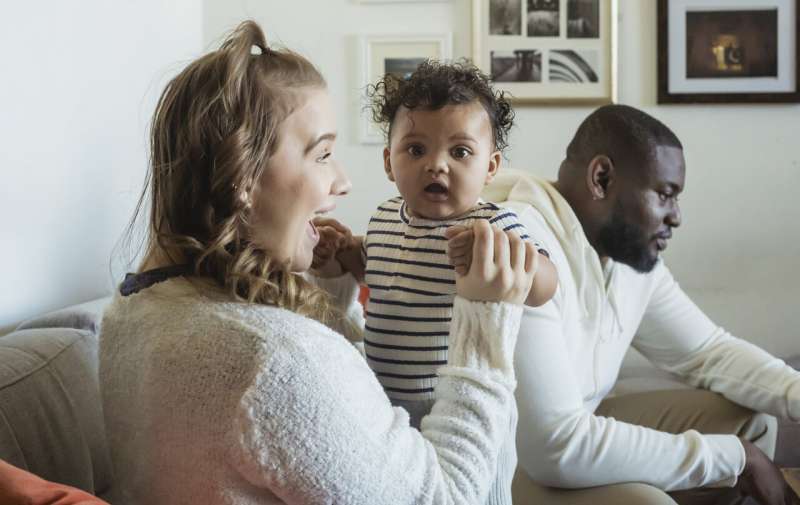
Babies born after March 11 2020 will have only known a world in the grip of a pandemic. They may never have met anyone who isn’t their parent, or they may only ever have seen their grandparents from a distance. They certainly will not have had the same opportunities to interact with other children as those born in the years before.
What are the implications for these pandemic children? While as researchers we do think that most babies will have had an opportunity to thrive, there’s still a lot we don’t know, and we are clear that the first months and years of life are vitally important for a child’s long-term health, development and wellbeing.
Development takes place at an extraordinary rate during a baby’s first year, when the brain doubles in size. This early development depends crucially on experience, and particularly social experience, which stimulates, tunes and hones the brain’s unfolding architecture.
A stimulating, varied and responsive environment supports the development of language, cognition and emotional and social competencies. This dependence on environmental input makes the brain exquisitely flexible and capable of adaptation. But, by the same token, it also means that babies are highly susceptible to the negative impacts of adversity.
One thing we also know with great certainty is that parental stress and mental health problems pose serious risks to children’s later development, affecting their language and cognitive development, their emotional wellbeing and putting them at risk of depression and anxiety themselves.
Unfortunately, support systems for babies and their families have been profoundly disrupted by the pandemic. As is sadly often the case, it is the most vulnerable and disadvantaged children who depend on these services and support networks the most.
For example, many health visitors, who provide advice and resources and who are often the main source of support and connection to health services for families with young babies, have been redeployed into the frontline COVID response during the pandemic. Those who remained have reported that their work with families was considerably affected by very high caseloads and the barriers created by social distancing measures.
Many expressed concerns about their ability to monitor children’s development and refer families to specialist support services when parents were experiencing mental health problems.
On top of that, friends and family have had their ability to visit loved ones and their babies drastically curtailed.
Social support from friends, family, community groups and professionals is normally considered vital not only because it provides infants with variety, stimulation and opportunities for learning, but also because it is good for the wellbeing of parents, on whom babies are so dependent.
So in these circumstances, what can parents do to help their babies? The evidence suggests that the key to optimal development is play and stimulation, those back-and-forth interactions between caregivers and babies.
Following a child’s lead when they take an interest in some item, naming objects, talking, laughing, singing and reading—all simple, minimal-cost activities—keep babies learning and developing even when the world outside is in difficulty.
Babies at risk
There are good reasons to be concerned about infant and early child development during this time and, like so many other things, these risks will not be evenly distributed.
The lack of support structures, the economic pressures and the drastic reduction in professional contact with health visitors and social workers during the pandemic is almost certainly placing large numbers of babies at greatly increased risk of harm, including risk of maltreatment and even death.
The effects of abuse on child development are profound and long-lasting, including long-term physical disability, emotional distress and mental health concerns. To give a striking example, nearly half of all adult mental health conditions are associated with a history of childhood maltreatment.
In normal times, maltreatment affects approximately 12%-23% of children, and children in economically disadvantaged circumstances are five times more likely to be subjected to abuse. In the UK, 51,510 children were on a child protection plan in March 2020 when the pandemic began.
During the pandemic, local authorities reported more than 300 serious incidents of injury and death involving children between April and October 2020—up by a fifth on the same time last year. An increased proportion (almost 40%) involved children under the age of one.
We also know that rates of domestic violence have increased greatly during the pandemic and babies are profoundly affected by this, both directly and indirectly.
Indeed, domestic violence is the single most common factor leading a child to bereferred to a child protection service. We sadly under-invest in the most vulnerable children at the best of times. We should be extremely concerned about them in times like these.
The baby blind spot
Babies need stimulation, social contact and responsive caregiving, and all of these will have been affected during the pandemic in complex ways, but we lack good evidence about how this is playing out.
Oxford Brookes University has conducted a study focused on how the pandemic is affecting children of the youngest ages, and in due course will provide us with much-needed insights. But it’s a concern that even now, a year in, we have very poor information about how babies and preschoolers have been affected by the momentous events that have taken place.
This highlights a key point: despite babies being among the most vulnerable in society and most dependent on nurturing care and stimulation, their needs are almost always the last to be noticed. The recent Working for Babies report called this the “baby blind-spot,” with good reason.
Source: Read Full Article






